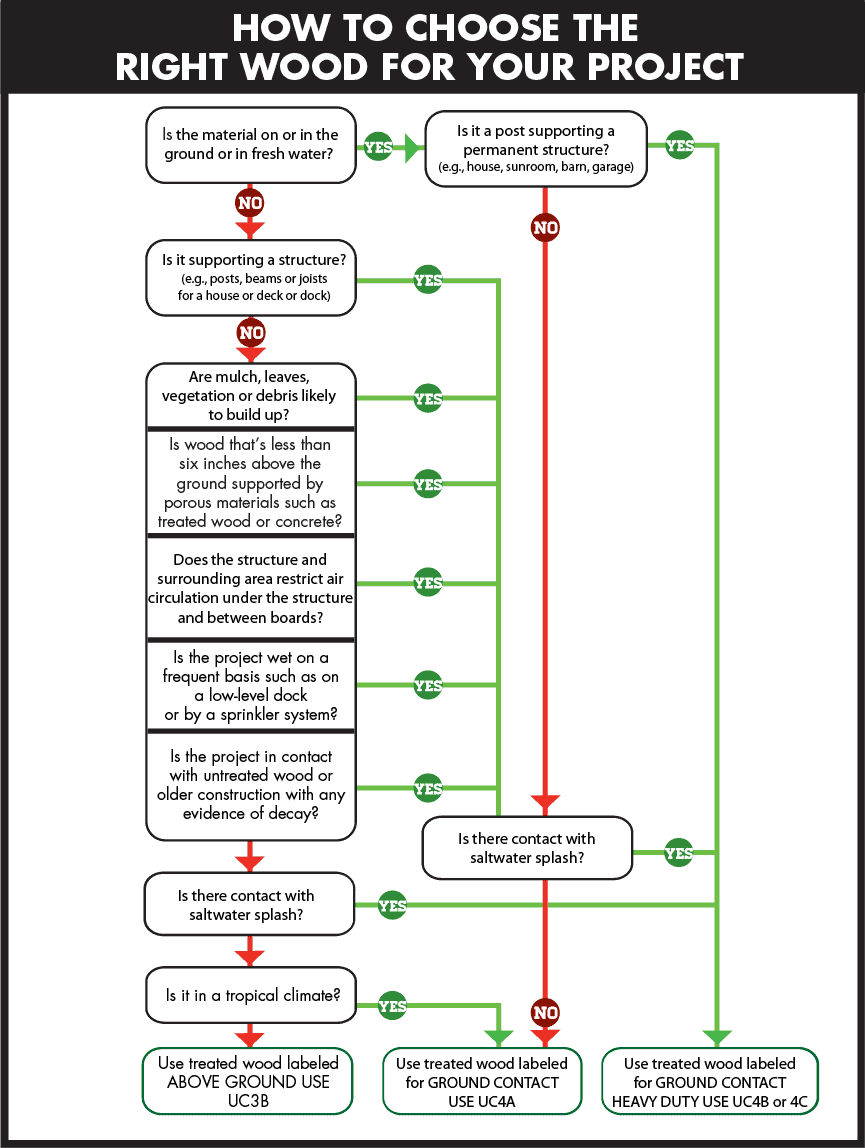Pressure Treated Wood: Choosing the right product
How to properly choose treated wood.
GROUND CONTACT
Ground Contact treated wood should be chosen for parts of your project that are:
• in ground or in contact with the ground
• in contact with debris, leaves or vegetation
• in fresh water
• exposed to daily wetting from sprinklers or other sources of moisture
• in contact with old wood that may be partially decayed
• posts supporting decks and fences (in ground or concrete)
• posts supporting fresh water docks
• all posts when secured by elevated post bases to concrete piers
• all joists and beams when critical and difficult to replace
• stair stringers that sit on the ground or on concrete on the ground
• low retaining walls, planter boxes, and understructure for walkways
• typical Above Ground uses in tropical climates
• material installed over water if it will be regularly wetted by waves and wakes
• less than 6” above ground and supported by permeable building materials
HEAVY DUTY GROUND CONTACT
Heavy Duty Ground Contact treated wood should be used for:
• posts supporting houses, garages, sunrooms, barns, or other permanent structures (in ground, concrete, or fresh water)
• saltwater splash
ABOVE GROUND
Wood treated for Above Ground is intended for parts of your project that meet all of the following criteria:
• is not on or in contact with the ground
AND
• is expected to readily dry out between times it gets wet
AND
• not located in tropical areas
Some components that are physically above ground still require Ground Contact.
See Ground Contact description to the left. In any of the situations listed there, wood treated for Ground Contact applications must be used even if the members are used in physically above-the-ground applications.
Above Ground applications include:
• deck boards, rails, spindles, lattice, benches, and step treads
• fence boards*
• outdoor furniture, such as Adirondack chairs and picnic tables used on a deck or other well-drained surface
*Fencing should not be in contact with the ground, debris, or vegetation. There should be adequate spacing under the fence boards to ensure airflow and drying.
NOTE: PLEASE SEE COUNTER SALES FOR REQUIRED END SEALING PRODUCTS.
The warranty requires surfaces that have been cut or trimmed and other holes or damage should be treated with a wood preservative end-cut solution in accordance with the label’s directions. Acceptable wood preservatives include Outlast® Q8 Log Oil or other products containing a minimum of 0.675% copper as oxine copper (copper-8 or copper-8-quinolinolate) or 1% copper as copper naphthalene.
REMEMBER, IF YOUR PROJECT IS IN CONTACT WITH THE GROUND OR FRESH WATER OR BUILT IN A MANNER THAT DOES NOT ALLOW THE WOOD TO EASILY DRY, GROUND CONTACT TREATED WOOD MUST BE USED.
› Please click HERE to download the flyer.
› Please click HERE for In-Stock Pressure Treated by Use Code.
*The International Code Council Evaluation Service (ICC-ES) standards that require that pressure-treated wood used in many physically above-ground applications be treated to Ground Contact requirements.




